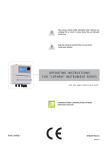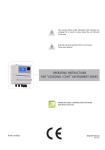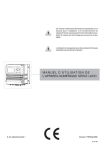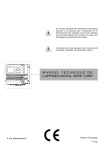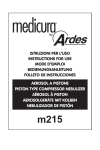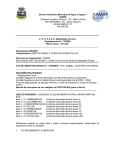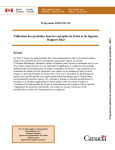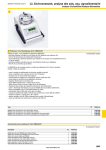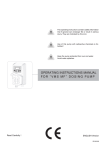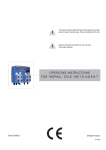Download OPERATING INSTRUCTIONS FOR “LDSTORBH
Transcript
This manual contains safety information that if ignored can
endanger life or result in serious injury. They are indicated
by this icon.
Keep the instrument protected from sun and water.
Avoid water splashes.
O P E R AT I N G I N S T R U C T I O N S
F O R “ L D S TO R B H ” I N S T R U M E N T S E R I E S
DOWNLOAD ERMES COMMUNICATION SOFTWARE
www.ermes-server.com
Read Carefully !
ENGLISH Version
1
R3-05-14
NORME CE
EC RULES(STANDARD EC)
NORMAS DE LA CE
Direttiva Basso Voltaggio
Low Voltage Directive
Directiva de baja tensión
๊
2006/95/CE
Direttiva EMC Compatibilità Elettromagnetica
EMC electromagnetic compatibility directive
EMC directiva de compatibilidad electromagnética
๊
2004/108/CE
GENERAL SAFETY GUIDELINES
Danger!
In emergencies the instrument should be switched off immediately! Disconnect the power cable
from the power supply!
When installing always observe local regulations!
Manufacturer is not liable for any unauthorized use or misuse of this product that may cause injury,
damage to persons and / or materials.
Caution!
Instrument must be accessible at all times for both operating and servicing. Access must not be
obstructed in any way!
Feeder should be interlocked with a no-flow protection device to automatically shut-off the pumps
when there is no flow!
Pumps and accessories must be serviced and repaired by qualified and authorized personnel only!
Always discharge the liquid end before servicing the instrument!
Empty and rinse the liquid end before work on a pump which has been used with hazardous or
unknown chemicals!
Always read chemical safety datasheet!
Always wear protective clothing when handling hazardous or unknown chemicals!
Instrument must be operated / serviced by trained technicians only!
All connection operations must be performed while the instrument is not connected to main
supply!
2
1. Introduction
LDTORBH is a microprocessor based digital regulator for NTU and temperature reading. On/Off is main working mode.
All information are provided through a large LCD display. Using a revolutionary wheel control the instrument can be
easily programmed. LDTORBH is housed in a IP65 plastic box.
INPUTS:
- Stand-by
- Flow
- Dissolved oxygen level
- Dissolved oxygen probe
- Temperature probe (embedded)
OUTPUTS:
- 1 relay output (NTU)
- 1 opto coupled pulses outputs (NTU)
- Main alarm
2. The wheel
Located in the upper right side of LDSTORBH there is a wheel that must be used to control the instrument. Wheel
can be rotated in both directions to scroll over the menus and / or pressed to confirm highlighted selection / value.
NOTE: Once changes are made press “OK” to save and exit from submenu. Press “ESC” to exit without saving.
SCROLL
Rotate wheel to scroll through menus or options
SELECT
Press wheel to select highlighted option
3
3. Mainboard Connections
MAIN
BOARD
DISPLATY BOARD
Unplug instrument from main power supply then perform connections by following the above picture.
30 31 32 33 34 35 36 37
USB or GSM or ETHERNET modules
(see this manual “Appendix”)
L 1 2 3 4 5
22 23 24 25 26 27 28 29
A
E E E E E E
14 15 16 17 18 19 20 21
B
NTU Probe
module connector
(see this manual “Appendix”)
N N N N N N
6 7
8 9 10 11 12 13
C
D
E
A: Main Fuse (6A T)
B: Instrument Fuse (3.15A T)
C - D - E : Factory reserved +5V
L(Live) - E (Earth) - N (Neutral): 85÷264VAC - 50/60 Hz
1(Live) - E(Earth) - N(Neutral): 85÷264VAC - 5A 50/60 Hz Relay 1 Output “PROBE CLEANING”.
2(Live) - E(Earth) - N(Neutral): 85÷264VAC - 5A 50/60 Hz Relay 2 Output “RELAY NTU”. To use with ON/OFF or PWM device
3(Live) - E(Earth) - N(Neutral): 85÷264VAC Alarm output
๊
31(-) - 32(+): Current output mA2 for NTU
34(-) - 35(+): Current output mA4 for temperature
Max resistive load: 500 Ohm
21(GND) - 28(+RS485) - 29(-RS485): RS485
14(+ Brown) - 15(Black) - 16(- Blue) - 17(GND): Proximity sensor mod. “SEPR”
11(-) - 10(+): Standby contact
6(Green) - 7(Brown) - 8(White) - 9(Yellow): PT100 temperature probe (if present remove jumper / resistance before to connect probe)
Warning: Connections must be perfomed by qualified and trained personnel only.
4
4. Main Screen
When into normal operating mode, LDSTORBH shows the following main screen:
GSM Signal*
UNIT (1)
Connection Status
LAN CONNECTION OK - ERMES CONNECTION OK
VALUES (2)
LAN CABLE DISCONNECTED
LAN CABLE CONNECTED - ERMES NOT AVAILABLE
OUTPUTS STATUS (3)
CONNECTED TO USB PEN-DRIVE
ERMES OK
WARNING MESSAGES
NOTIFICATION AREA
Main screen zones:
(1) UNIT
“NTU” is the measuring unit for turbidity probe.
(2) VALUES
These numbers are values read by the probes.
According to selected scale (see “Set Scale” menu at page 11), this field may be different.
(3) OUTPUTS STATUS
These fields are related to current outputs status and instrument activity.
For more information rotate the wheel when into main screen. (see next page)
WARNING MESSAGE
NOTIFICATION AREA
During critical situations a warning / alarm message may appear. To
in-depth explanation completely rotate clockwise the wheel to review main
instrument parameters and current outputs status.
*with GSM Modem installed
Note: the word “PUMP” as shown into this manual refers to a “dosing device” connected to the instrument!
5
5. Quick status check
From main screen completely rotate clockwise the wheel to review main instrument parameters and current outputs
status.
Local Time
Local Date
Turbidity probe reading
Temperature probe reading
Dosing alarm condition
Probe failure status
Alarm contact status
Flow contact status
Last Temp. calibration result
Last Temp. calibration date
Outputs Status
See mainboard (page 4) for related connetions.
6
6. Password
To grant access into “Main Menu” press the wheel from main screen and enter the passcode.
If this is the first time here then the passcode is 0000 (factory preset). Press wheel 5 times to enter into “Main
Menu”. Otherwise press the wheel 1 time and enter the passcode. Numbers can be selected rotating the wheel.
X5
To set a new passcode choose “PARAMETERS” from “Main Menu” , move on “New Pcode”, click on wheel and
enter a four numbers code. Click on “EXIT” and choose “YES” to save request. The new passcode is now ready.
Lost passcode ?
Please dont’ forget the passcode (if changed). In the unfortunate event, please call your local distributor for unlocking procedure. There is no way for you
to recover lost passcode.
7
7. “Main Menu” list
To grant access into “Main Menu” enter the passcode (as described in previous chapter). Once into “Main Menu”
rotate the wheel to scroll through all the options available.
Setpoint (see page 9)
Calibration (see page 11)
Parameters (see page 13)
Output manager (see page 14)
Instrument reset (see page 15)
Dosing alarm (see page 16)
International (see page 17)
Probe Failure (see page 18)
Flow (see page 19)
Service (see page 19)
Log Setup (see page 20)
RS485 Setup (see page 28)
Out of Range Alarm (see page 22)
SMS menu (see page 28)
TCP IP (see page 29)
GPRS (see page 30)
Email (see page 30)
mA Outputs (see page 21)
Log View (see page 31)
Self Clean (see page 10)
8
8. “Set-Point”, NTU (on/off)
On/Off setpoint mode set the instrument to operate using two set values that enable or disable the
“NTU Relay”. Press wheel for editing.
ON/OFF mode
Set NTU value at 4.00 OFF and 10.00 ON.
Instrument will leave “Relay 1 Output” active until reading value will decrease up to 4.00NTU.
At 4.00NTU the “Relay 1 Output” will be disabled until reading value will increase up to 10.00NTU.
Note: On/Off mode can’t be changed.
ON
OFF
10.00
4.00
9
9. “Self clean”, probe self-cleaning setup (Relay 1 Output)
An internal motor automatically wipes the optical face of probe. To define how much this motor must be on or off
use the “Self Clean” menu.
“Cycle”: the time between each cleaning. Can be set between 0 (disabled) and 999 minutes. Setting “0” as value
the whole “Self-Clean” function will be disabled.
“Clean Time”: probe cleaning time. Can be set between 0 (disabled) and 999 seconds. Setting “0” as value the
whole “Self-Clean” function will be disabled.
“Restore Time”: is the probe recovery time needed to come back in full operations after the cleaning.
Can be set between 0 (disabled) and 999 minutes. Setting “0” as value the whole “Self-Clean” function will be
disabled.
“Clean on alarm”: automatic probe cleaning when the reading alarm is active. The probe will not read until the
end of the cleaning.
Note: During “Clean Time”, “Restore Time” and “Clean on alarm” all NTU outputs are DISABLED.
10
10. “NTU scale set” (Menu Calibration)
To properly set probe reliability is possible to set: probe’s RANGE ( between 9,999NTU or 99,99NTU or 999,9NTU
or 9999NTU), NTU probe calibration based on two points (zero and slope) or get back to original NTU calibration
parameters.
Turbidity sensor is shipped fully calibrated (plug&play) so usually doesn’t need to be calibrated. However by selecting “NTU probe” within “Calibration menu” a two points calibration can be performed.
P1: zero value. Can’t be
edited. Dip probe’s head
into a 0NTU solution and
press wheel once reading
field is stable.
P2: slope value. Dip
probe’s head into a known
buffer solution and enter
value once reading field
is stable.
Please
read
probe’s
manufacturer instructions
to achieve best results.
To get back to original NTU calibration parameters
enter into “Default Calibration NTU” menu and confirm operation by changing OFF to ON then moving
on OK and pressing the wheel.
11
10.1 “Temp probe”, °C - Temperature (Menu calibration)
A professioanl thermometer is required to obtain a reliable calibration. Within “Calibration” menu choose “Temp probe”.
1RWH7KLVSURFHGXUHDVVXPHVWKDWLQVWUXPHQWLVFRUUHFWO\LQVWDOOHGDQGFRQÀJXUHGFRQQHFWHGWRDZRUNLQJ
NTC temperature probe (embedded). Calibrate using plant’s temperature otherwise unattended results may
occur.
8VLQJDQH[WHUQDOWKHUPRPHWHUUHDGDFWXDOWHPSHUDWXUHDQGHGLWUHODWHG¿HOG³&DODW´&RQ¿UPE\SUHVVLQJZKHHO
7RHQGSURFHGXUHPRYHFXUVRURQ³2.´DQGSUHVVZKHHOWRSURFHHGWR³6DYH´UHTXHVWVFUHHQ0RYHZKHHORQ
“YES” to save or “NO” to discard changes. If an error occurred during calibration procedure then the instrument
ZLOOVKRZDQHUURUPHVVDJHDQGZLOODVNWRSURFHHGWRD
QHZ FDOLEUDWLRQ FDQFHO FXUUHQW RSHUDWLRQ RU UHVWRUH GHfault settings.
12
11. “Parameters”
)URP³0HQX&DOLEUDWLRQ´FKRRVH³3DUDPHWHUV´7KLVPHQXDOORZVWRVHWDGHOD\PD[PLQXWHVEHIRUHSXPSVEHJLQ
to feed. Furthermore use this menu to change default passcode.
Feeding Delay.
0RYHRQ³)HHGLQJ'HOD\´WKHQSUHVVZKHHO&KRRVHDYDOXHEHWZHHQGLVDEOHGDQGPLQXWHVPD[LPXPGHOD\
WLPH7KLVIHDWXUHFDQEHXVHGWRDFFRUGDVWDUWXSGHOD\IRUWKHSXPSV'HOD\RFFXUVZKHQLQVWUXPHQWLVSRZHUHGRU
DIWHUD³12)/2:´FRQWDFWUHFRYHU\
Tau.
Not editable function.
New Pcode.
6HHSDJH
7RHQGSURFHGXUHPRYHFXUVRURQ³2.´DQGSUHVVZKHHOWRSURFHHGWR³6DYH´UHTXHVWVFUHHQ0RYHZKHHORQ³<(6´WR
save or “NO” to discard changes.
13
12. “Output Manager”
From “Menu Calibration” choose “Output Manager”. This menu allows to manually operate all outputs for a
settable time. Set to “AUTO” for normal operating mode. Set to “OFF” to permanently disable outputs.
Press wheel to move cursor on “TIME” field. Once here, choose a working time between 0 (disabled) or 199
minutes. Move on “EXIT”, then press wheel.
Choose “YES” to save changes. Exit from main menu. Main display will show a countdown for selected output.
To stop this countdown go back to “Output Manager” menu and choose “AUTO” as working mode or wait until
countdown ends. This function can be used for priming purposes.
14
13. “Instrument Reset”
To restore instrument to its default values (including password) once into “Instrument Reset” menu, press wheel
then change value to “ON”, press wheel again, move on “OK” then finally press wheel. The instrument display
will show “CHECKSUM ERROR”. Press whell to return into “Main Menu”. Move on “EXIT”, then press wheel. The
instrument is now restored to factory default. Please repeat all calibration procedures and programming parameters.
15
14. “Dosing Alarm”
Use this menu to assign a maximum time to the pumps for reaching the setpoint. If set time ends and the pumps
are still dosing, within this menu is possible to STOP them or just to show an alarm message. Function can be
disabled selecting “OFF” instead of a number (minutes). Dosing alarm can be set for both or just one pump.
E.g. To set NTU pump to stop after time ends and setpoint isn’t still reached press wheel, choose maximum time,
press wheel move on next field and choose “STOP”. Time can be set between 0 and 100 minutes. When satisfied
with settings move on exit and press wheel.
To end procedure move cursor on “OK” and press wheel to proceed to “Save” request screen. Move wheel on “YES”
to save or “NO” to discard changes.
16
15. “International”
Use this menu to set international parameters as UNIT FORMAT (Europe IS or USA), Local Time and Date.
Format.
Use this option to use European or USA units format. See table for differencies.
EUROPE IS (Internationl Standard)
USA
Date (DD/MMM/YY)
Date (MMM/DD/YY)
Time 24h
Time AM / PM
°C
°F
Time.
Use this option to set local time.
Date.
Use this option to set date.
Move on exit to end changes.
To end procedure move cursor on “OK” and press wheel to proceed to “Save” request screen. Move wheel on
“YES” to save or “NO” to discard changes.
17
16. “Probe Failure”
Use this menu to assign a maximum time for connected probes to stay in “stuck” condition. A stuck probe (it
remains on same reading value for some time) means that probably probe itself is damaged. Within this menu
is possible to STOP pumps or just to show an alarm message (probe failure) . Function can be disabled selecting
“OFF” instead of a number (minutes). This function can be set for both or just one probe.
E.g. To set NTU pump to stop after time ends and probe doesn’t change reading values press wheel, choose maximum time, press wheel move on next field and choose “STOP”. Time can be set between 100 and 254 minutes.
When satisfied with settings move on exit and press wheel.
To end procedure move cursor on “OK” and press wheel to proceed to “Save” request screen. Move wheel on “YES”
to save or “NO” to discard changes.
18
17. “Flow Contact”
Flow contact (see “SEPR” blocks on page 4) can be enabled to stop a dosing procedure using a N.O. contact mode
(normally open) or N.C. contact mode (normally closed) when status on blocks changes. Rotate wheel to choose
between: “DISABLE”, “REVERSE” (N.O. contact) or “DIRECT” (N.C. contact).
Furthermore “Flow contact” can starts after a specified time when contact status changes. To set it move wheel on
“Time:00 min”, click it and rotate to choose time (from 0 to 99 minutes). Confirm selection by clicking wheel.
To end procedure move cursor on “OK” and press wheel to proceed to “Save” request screen. Move wheel on
“YES” to save or “NO” to discard changes.
17. “Service”
This “view only” menu shows probes reading live and instrument ID for USB LOG connection (if device’s connected). Press “ESC” to exit.
Connection Code for ERMES (through USB cable)
Connection Code for ERMES (through LAN cable)
19
18. “Log Setup”
Log setup stores instrument activities when an alarm (flow, level, out of range reading, etc.) occurs.
Log activity recording can be started by moving wheel on “Mode: Disable” and changing it to “Mode: Enable”.
Log activity starting time can be set to begin at specified time by entering “Time”. Activities data are collected
every specified hour or minutes. Edit this parameter by moving wheel on “Every: 00:00” and changing it to desired
time.
ID and Station Name as
appears on a received SMS from
instrument
20
19. “mA Outputs”
This menu allows to configure mA current otput for Dissolved oxygen. Options to set are:
MODE (selectable between 0-20 or 4-20 mA current output)
Max mA: maximum probe’s reading value at 20 mA current
Min mA: minimum probe’s reading value at 0 or 4 mA current
Rotate wheel to move within all 3 channels. Click wheel to selecte parameter and rotate wheel to change it. Click
wheel again and rotate wheel to move cursor on next parameter.To end procedure move cursor on “EXIT” and press
wheel to proceed to “Save” request screen. Move wheel on “YES” to save or “NO” to discard changes.
This menu is available only for “LDSxx” instrument series with current outputs option enabled.
21
20. “Out of range alarm”
“Out of range alarm” menu defines the minimum and maximum NTU value read by the probe before to stop
connected device activity and to show an alarm message.
Move wheel on “NTU Hi: Dis.” and change
status from “Dis.” (option disabled) to “En.”
(option enabled) by clicking on wheel and
rotating it. Press wheel again and move on
next field. Press wheel and enter a value for
HIGH alarm.
Repeat procedure for “NTU Lo: Dis.” and
enter a value for LOW alarm.
As last option enter “Time” (max 99
minutes) after which if lower or higher read
value condition stays then the alarm occurs
(to set into mode field).
To change alarm mode move wheel on
“Mode”, press it and choose between
“OUT ON” (connected device will not stop
activity when read value is out of range)
or “OUT OFF” (connected device will stop
activity when read value is out of range and
an alarm message is displayed).
22
21. Technical information.
Power supply: 85÷264 VAC
NTU Range: 9,999NTU or 99,99NTU or 999,9NTU or 9999NTU
Environment Temperature: -10 ÷ 45°C (14 ÷ 113°F)
Chemical Temperature: 0 ÷ 50°C (32 ÷ 122°F)
Installation Class: II
Pollution Level: 2
Packaging and Transporting Temperature: -10 ÷ 50°C (14 ÷ 122°F)
Protection degree: IP 65
Product
Formula
Ceram.
PVDF
PP
PVC
SS 316
PMMA
Hastel.
PTFE
FPM
EPDM
NBR
PE
Acetic Acid, Max 75%
CH3COOH
2
1
1
1
1
3
1
1
3
1
3
1
Hydrochloric Acid, Concentrate
HCl
1
1
1
1
3
1
1
1
1
3
3
1
+\GURÀXRULF$FLG
H2F2
3
1
3
2
3
3
2
1
1
3
3
1
3KRVSKRULF$FLG
+32
1
1
1
1
2
1
1
1
1
1
3
1
Nitric Acid, 65%
HNO3
1
1
2
3
2
3
1
1
1
3
3
2
Sulphuric Acid, 85%
+62
1
1
1
1
2
3
1
1
1
3
3
1
Sulphuric Acid, 98.5%
+62
1
1
3
3
3
3
1
1
1
3
3
3
Amines
R-NH2
1
2
1
3
1
-
1
1
3
2
3
1
Sodium Bisulphite
NaHSO3
1
1
1
1
2
1
1
1
1
1
1
1
Sodium Carbonate (Soda)
Na2CO3
2
1
1
1
1
1
1
1
2
1
1
1
Ferric Chloride
FeCl3
1
1
1
1
3
1
1
1
1
1
1
1
Calcium Hydroxide (Slaked Lime)
Ca(OH)2
1
1
1
1
1
1
1
1
1
1
1
1
Sodium Hydroxide (Caustic Soda)
NaOH
2
1
1
1
1
1
1
1
2
1
2
1
Calcium Hypochlor.(Chlor.ted Lime)
Ca(OCl)2
1
1
1
1
3
1
1
1
1
1
3
1
Sodium Hypochlorite, 12.5%
NaOCl + NaCl
1
1
2
1
3
1
1
1
1
1
2
2
3RWDVVLXP3HUPDQJDQDWH
.0Q2
1
1
1
1
1
1
1
1
1
1
3
1
+\GURJHQ3HUR[LGH3HU\GURO
H2O2
1
1
1
1
1
3
1
1
1
2
3
1
Aluminium Sulphate
$O62
1
1
1
1
1
1
1
1
1
1
1
1
Copper-II-Sulphate (Roman Vitriol)
&X62
1
1
1
1
1
1
1
1
1
1
1
1
Resistance rating: (1: Resistant) ; (2: Fairly resistant) ; (3: Not resistant)
3RO\YLQ\OGHQHÁXRULGH39') Pump Heads, valves, fitting, tubing
Polypropylene (PP) Pump Heads, valves, fitting, level floater
PVC Pump Heads
Stainless steel (SS 316) Pump Heads, valves
Polymethyl Metacrilate (Acrylic) PMMA Pump Heads
Hastelloy C-276 Injection valve spring
3RO\WHWUDÁXRURHWK\OHQH37)( Diaphragm
Fluorocarbon (Viton® B) Sealings
Ethylene propylene (EPDM) Sealings
Nitrile (NBR) Sealings
Polyethylene (PE) Tubing
23
22. SEPR configuration
SEPR “Flow Sensor” configuration for two instruments
black
16 17
14
15
16 17
blue
15
brown
14
SEPR
Configuration of a Flow Switch with a voltage free contact and two instruments
black
16 17
blue
15
brown
14
N.C. contact (OK)
N.O. contact (Alarm)
NPED4
24
14
15
16 17
Appendix A - MDDO probe series module
Located under mainboard cover there are two connectors that can be used to install probe modules. Modules come
pre-installed upon request and may appear different as shown (different configurations). Identify installed modules
to correctly connect probes. From Calibration Menu choose “Select Probe” and according to installed probe
select required model.
Module suitable for ETORBH probe
Connect probe as follows:
1 Green
2 Yellow
3 Black
4 White
5 Brown
If pobe is supplied with extra cable connect wires as follows:
1
2
3
4
5
1 Green
2 Yellow
3 Black+ White
4 Blu
5 Brown+Red
25
Appendix Communication HARDWARE - “SMS/GSM” Module
Located under mainboard cover there is a four pins connector that can be used to install USB, ETHERNET or MODEM
modules. Modules come pre-installed upon request and may appear different as shown (different configurations).
´606*06PRGXOHµFDQEHFRQÀJXUHGWRVHQG606PHVVDJHVFRQWDLQLQJFULWLFDOLQVWUXPHQWLQIRUPDWLRQ
Insert here standard
SIM
Unplug
instrument
from main supply
before to open it.
GSM modem antenna connector
To obtain reliable results with this feature please check the following list:
- Make certain the antenna location is not shielded by metal objects or near sources of electrical ‘noise’.
- Do not route the cable where it could be pinched in doors, windows etc.
- Secure the antenna cable
- Ensure that SIM into “SMS/GSM modeule” is properly inserted, activated and within operator range.
- Set instrument ID / NAME from “RS485 Setup” menu and configure “Out of Range Alarm” menu.
Within “Main menu” select “SMS MENU” to enable SMS service and enter SMS receiver phone numbers.
To enable warning message for related alarm
condition choose “ON”, to disable choose “OFF”.
Then move wheel on Exit and SAVE configuration.
606ZLOOEHVHQWZKHQRQHRUPRUH´21µÀHOGVZLOO
change.
Msg Flow: flow alarm
Msg Al NTU: Reading alarm
Msg Dos. NTU: Dosing alarm
Up to three numbers for sending SMS can be stored
into LDSTORBH memory. SMS recipient will receive
an SMS containing instrument ID, NAME and status.
Number formats can be stored using international
prefix “+”, international prefix “00” or local.
WARNING: THIS FUNCTION COULD NOT BE
FREE OF CHARGE. DEPENDING ON YOUR OPERATOR CONTRACT IT
COULD GENERATE PAYING SMS TRAFFIC !
26
WARNING: TO AVOID UNDESIRED MESSAGES USE CAREFULLY THIS
SETUP!
Appendix Communication HARDWARE - “LOG USB” Module
Located under mainboard cover there is a four pins connector that can be used to install “USB data log module”
or “SMS module”. Modules come pre-installed upon request and may appear different as shown (different
configurations).
“USB data log module” records instrument activities. These information can be permanently stored into a standard
USB pendrive. Pendrive can be connected to a PC using “ERMES” software to review and print instrument’s activities.
To obtain reliable results with this feature please set instrument ID and NAME from “RS485 Setup” menu
and activate log recording from “LOG SETUP” menu.
$FWLYLW\/('
3RZHU/('
Standard USB pendrive
QRWLQFOXGHG
Insert USB pendrive here
ULJKWVLGHRILQVWUXPHQW
$IWHUXVDJHSXWEDFN86%FDS
HOW TO RECORD INSTRUMENT’S ACTIVITIES INTO USB PENDRIVE ?
Insert USB pendrive into USB connector (located on the right side of instrument). Instrument will save data log on
USB pendrive. After succeded in saving data it will ask if delete instrument’s log or not (anyway USB pendrive will
not be formatted). Move wheel on “YES” to delete log info from instrument and return to main screen or “NO”
to leave log info on instrument and return to main screen. Wait about 30 seconds to safety remove the USB
pendrive.
HOW TO REVIEW INSTRUMENT’S ACTIVITIES RECORDED INTO USB PENDRIVE ?
It’s necessary to install the “ERMES COMMUNICATION SOFTWARE” to review USB pendrive info on a PC. Follow
installation instructions during software setup to correctly complete this procedure. Once the software has been
installed and launched insert your USB pendrive into any available USB connector of PC. Instrument’s log will be
automatically uploaded into PC memory. See “ERMES COMMUNICATION SOFTWARE”5 quick guide for more info.
27
Appendix Communication - Software
“RS485” menu.
3ULRUWRLQVWDOOWKHLQVWUXPHQWLQWRDQ56ORFDOV\VWHPDXQLTXH,'180%(5IURPWRDQG,'1$0(VWDWLRQ
QDPHPXVWEHVHW5RWDWHZKHHODQGHGLW¿HOGV,I,'QXPEHUKDVDOUHDG\DVVLJQHGDQHUURUPHVVDJHZLOOIROORZDIWHU,'
&KHFNPRYHFXUVRURQ&+(&.DQGSUHVVZKHHO,QWKLVHYHQWWU\XVLQJDQRWKHUQXPEHU
Choose
Edit
“SMS” menu.
,QVWUXPHQWPD\UHPRWHO\VHQG606DODUPPHVVDJHVXVLQJLWVRZQPRGHPVROGDVRSWLRQ,WFDQEHFRQ¿JXUHGDV
IROORZV
SMS1 / SMS2 /SMS3.
8VLQJWKHZKHHOHQWHUDPRELOHSKRQHWKDWZLOOUHFHLYHDOHUW606PHVVDJHVLIVRPHWKLQJZURQJRFFXUUV606QXPEHU
PXVWEHVHWXVLQJORFDOQXPEHUIRUPDW)RUH[DPSOHZLOOVHQGDQ606PHVVDJHWRPRELOHSKRQH
/RJOHYHODQG606IUHTXHQF\DOHUWPD\EHVHWXVLQJRSWLRQVLQ³$&7,9(06*´ZLWKLQ³*60PHQX´
Choose
Edit
- TO AVOID UNDESIRED MESSAGES USE CAREFULLY LOG SETUP - WARNING: THIS FUNCTION COULD NOT BE FREE OF CHARGE. DEPENDING ON YOUR OPERATOR CONTRACT IT
COULD GENERATE PAYING SMS TRAFFIC !
28
Appendix Communication - Software
“TCP/IP” menu.
7KHLQVWUXPHQWPD\EHUHPRWHO\RSHUDWHGXVLQJDVWDQGDUGHWKHUQHWFRQQHFWLRQVROGDVRSWLRQ$VWDWLFRUG\QDPLF,3
DGGUHVVDQGD&$7HWKHUQHWFDEOHLVUHTXLUHG$FFRUGLQJWR\RXUQHWZRUNFDSDFLW\FRQQHFWLRQVSHHGLV0ESV
7RREWDLQDYDOLG,3DGGUHVVDQGVXEQHWPDVNFRQWDFW\RXUQHWDGPLQLVWUDWRU(QWHUSDUDPHWHUVDQGPRYHFXUVRURQ
³6$9(´WRVWRUHSDUDPHWHUVWKHQPRYHRQ³2.´DQGSUHVVZKHHOWRVDYHDQGDFWLYDWHFRQ¿JXUDWLRQ
%DVHGRQ\RXUQHWZRUNFRQ¿JXUDWLRQFKRRVHWRREWDLQQHWZRUNSDUDPHWHUVDXWRPDWLFDOO\'<1$0,&RUPDQXDOO\
67$7,&
6HH³(50(6&RPPXQLFDWLRQ6RIWZDUH´PDQXDOIRUSURSHU3&VRIWZDUHFRQ¿JXUDWLRQ
What is a static IP address/dynamic IP address?
A static IP address is a number (in the form of a dotted quad) that is assigned to a computer by an Internet service provider (ISP)
to be its permanent address on the Internet. Computers use IP addresses to locate and talk to each other on the Internet, much the
same way people use phone numbers to locate and talk to one another on the telephone. When you want to visit whatis.com, your
computer asks a domain name system (DNS) server (think telephone information operator) for the correct dotted quad number
(think phone number) for whatis.com and your computer uses the answer it receives to connect to the whatis.com server.
It would be simple if every computer that connects to the Internet could have its own static IP number, but when the Internet was
¿UVWFRQFHLYHGWKHDUFKLWHFWVGLGQ¶WIRUHVHHWKHQHHGIRUDQXQOLPLWHGQXPEHURI,3DGGUHVVHV&RQVHTXHQWO\WKHUHDUHQRWHQRXJK
IP numbers to go around. To get around that problem, many Internet service providers limit the number of static IP addresses
they allocate, and economize on the remaining number of IP addresses they possess by temporarily assigning an IP address to
DUHTXHVWLQJ'\QDPLF+RVW&RQ¿JXUDWLRQ3URWRFRO'+&3FRPSXWHUIURPDSRRORI,3DGGUHVVHV7KHWHPSRUDU\,3DGGUHVVLV
called a dynamic IP address.
Requesting DHCP computers receive a dynamic IP address (think temporary phone number) for the duration of that Internet sesVLRQRUIRUVRPHRWKHUVSHFL¿HGDPRXQWRIWLPH2QFHWKHXVHUGLVFRQQHFWVIURPWKH,QWHUQHWWKHLUG\QDPLF,3DGGUHVVJRHVEDFN
into the IP address pool so it can be assigned to another user. Even if the user reconnects immediately, odds are they will not be
assigned the same IP address from the pool. To keep our telephone telephone analogy going, using a dynamic IP address is similar to using a pay phone. Unless there is a reason to receive a call, the user does not care what number he or she is calling from.
There are times, however, when users who connect to the Internet using dynamic IP wish to allow other computers to locate them.
Perhaps they want to use CU-SeeMe or use a VoIP application to make long distance phone calls using their IP connection. In that
case, they would need a static IP address. The user has two choices; they can contact their ISP and request a static IP address, or
they can use a dynamic DNS service. Either choice will probably involve an additional monthly fee.
8VLQJDG\QDPLF'16VHUYLFHZRUNVDVLIWKHUHZDVDQROGIDVKLRQHGWHOHSKRQHPHVVDJHVHUYLFHDW\RXUFRPSXWHU¶VGLVSRVDO
:KHQDXVHUUHJLVWHUVZLWKD'16VHUYLFHDQGFRQQHFWVWRWKH,QWHUQHWZLWKDG\QDPLF,3DGGUHVVWKHXVHU¶VFRPSXWHUFRQWDFWV
the DNS service and lets them know what IP address it has been assigned from the pool; the service works with the DNS server
to forward the correct address to the requesting DHCP computer. (Think of calling the message service and saying “Hi. I can be
reached at 435.44.32.111 right now. Please tell anyone who tries to reach me to call that number.) Using a dynamic DNS service to
DUUDQJHIRUFRPSXWHUVWR¿QG\RXHYHQWKRXJK\RXDUHXVLQJDG\QDPLF,3DGGUHVVLVWKHQH[WEHVWWKLQJWRKDYLQJDVWDWLF,3
29
Appendix Communication - Software
“GPRS” menu.
,QVWUXPHQWPD\EHUHPRWHO\RSHUDWHGXVLQJDQHPEHGGHGVWDQGDUG*356PRGHPVROGDVRSWLRQ,QRUGHUWRDFWLYDWH
WKLVVHUYLFHSOHDVHHQVXUHWKDWWKHIROORZLQJVWHSVDUHFRUUHFWO\FRPSOHWHG
0DNHFHUWDLQWKHDQWHQQDORFDWLRQLVQRWVKLHOGHGE\PHWDOREMHFWVRUQHDUVRXUFHVRIHOHFWULFDOµQRLVH¶
0DNHFHUWDLQWKHGLVWDQFHIURPWKHDQWHQQDWRWKH³,QVWUXPHQW´XQLWLVZLWKLQFDEOHOHQJWK
'RQRWURXWHWKHFDEOHZKHUHLWFRXOGEHSLQFKHGLQGRRUVZLQGRZVHWF
(QVXUHWKDW6,0LQWR³,QVWUXPHQW´PRGHPLVFRUUHFWO\LQVHUWHGDFWLYDWHGDQGZLWKLQRSHUDWRUUDQJH
6HH³(50(6&RPPXQLFDWLRQ6RIWZDUH´PDQXDOIRUSURSHU3&VRIWZDUHFRQ¿JXUDWLRQ
,QVWUXPHQWFDQEHVHWIRUDXWRPDWLFFRQ¿JXUDWLRQ&RQ¿JXUDWLRQRSWLRQVHWWR³$XWRPDWLF´RUPDQXDOO\&RQ¿JXUDWLRQ
RSWLRQVHWWR³0DQXDO´EDVHGRQ\RXU6,0GDWDDFFHVVSDUDPHWHUV)RUPDQXDOFRQ¿JXUDWLRQRSWLRQHQWHU$31DFFHVV
SRLQWQDPHDQG6,0SKRQHQXPEHU0RYHZKHHORQ³2.´WRVDYHDQGPRYHRQ³(6&´WRJREDFNWRPDLQPHQX
WARNING: THIS FUNCTION COULD NOT BE FREE OF CHARGE. DEPENDING ON YOUR OPERATOR CONTRACT IT
COULD GENERATE PAYING DATA TRAFFIC !
“Email” menu.
,I(WKHUQHWPRGXOHRU*356PRGXOHLVLQVWDOOHGVROGDVRSWLRQWKHLQVWUXPHQWFDQEHFRQ¿JXUHGWRVHQGHPDLODODUP
PHVVDJHVXSWRWZRUHFLSLHQWV&OLFNRQ³(PDLO´RU³(PDLO´DQGHQWHUHPDLODGGUHVV
$FFHVVSRLQWQDPH$31LGHQWL¿HVDQ,3SDFNHWGDWDQHWZRUN3'1WKDWDPRELOHGDWDXVHUZDQWVWRFRPPXQLFDWHZLWK,QDGGLWLRQWRLGHQWLI\LQJD3'1DQ
$31PD\DOVREHXVHGWRGH¿QHWKHW\SHRIVHUYLFHHJFRQQHFWLRQWRZLUHOHVVDSSOLFDWLRQSURWRFRO:$3VHUYHUPXOWLPHGLDPHVVDJLQJVHUYLFH006WKDW
LVSURYLGHGE\WKH3'1$31LVXVHGLQ*33GDWDDFFHVVQHWZRUNVHJJHQHUDOSDFNHWUDGLRVHUYLFH*356HYROYHGSDFNHWFRUH(3&
30
Appendix Communication - Software
“LOG” menu.
7KLVIXQFWLRQUHFRUGVLQVWUXPHQWDFLWYLW\GDWHKRXUWHPSHUDWXUHX6WRWDOL]HU,2DODUPVRXWSXWV,WVWDUWVIRU
VHOHFWHGIUHTXHQF\SHULRGHYHU\DWUHTXHVWHGWLPHWLPH6(7'$7(7,0(%()25(72(1$%/(/2*,)127
32:(5(')25$%287'$<67+(,167580(17:,///226('$7(7,0(
Set ACTIVE to “enabled” to activate log recording.
7,0(UHFRUGLQJVWDUWWLPHWLPHIRUPDWKHPLQ
(9(5<UHFRUGLQJIUHTXHQF\WLPHIRUPDWKHPLQ
1RWH DGYDQFHG ORJ FRQWURO JUDSK SULQWLQJ FRPSDULVRQ WDEOHV HYHQW ¿OWHULQJ HWF LV DYDLODEOH WKURXJK ³(50(6
&RPPXQLFDWLRQ6RIWZDUH´IRU3&
6HH³(50(6&RPPXQLFDWLRQ6RIWZDUH´PDQXDOIRUSURSHU3&VRIWZDUHFRQ¿JXUDWLRQ
“LOG VIEW” menu.
7RVHHDODUUPORJHQWULHVDVVHWRQORJPHQXFKRRVH³ORJYLHZ´RQPDLQPHQX
31
Appendix E - Dimensions
mm
32
Index
1. Introduction ................................................................................... 3
2. The wheel....................................................................................... 3
3. Mainboard Connections.................................................................. 4
4. Main Screen ................................................................................... 5
5. Quick status check.......................................................................... 6
6. Password ....................................................................................... 7
7. “Main Menu” list ........................................................................... 8
8. “Set-Point”, NTU............................................................................ 9
9. “Calibration” / “NTU Scale” ........................................................... 11
9.1 “Temp probe”, °C - Temperature .................................................. 12
10. “Parameters” ............................................................................... 13
11. “Output Manager”....................................................................... 14
12. “Instrument Reset” ...................................................................... 15
13. “Dosing Alarm”............................................................................ 16
14. “International”............................................................................. 17
15. “Probe Failure” ............................................................................ 18
16. “Flow Contact” ........................................................................... 19
17. “Service”..................................................................................... 19
18. “Log Setup”................................................................................. 20
19. “mA Outputs”.............................................................................. 21
20. “Out of range alarm” ................................................................... 22
21. Technical information.................................................................... 23
22. SEPR configuration ....................................................................... 24
Appendix A - NTU probe series module............................................... 25
Appendix Communication HARDWARE - “SMS/GSM” Module ............ 26
Appendix Communication HARDWARE - “LOG USB” Module.............. 27
Appendix Communication - Software.................................................. 30
Information on this manual may contain technical inaccuracies or typographical errors.
7KHLQIRUPDWLRQFRQWDLQHGPD\EHFKDQJHGDWDQ\WLPHZLWKRXWSULRUQRWLÀFDWLRQRUREOLJDWLRQ
33
34
35
When dismantling this instrument please separate material types and send them according to local recycling disposal requirements.
We appreciate your efforts in supporting your local Recycle Environmental Program.
Working together we’ll form an active union to assure the world’s invaluable resources are conserved.
36




































